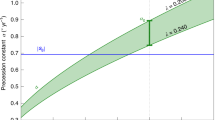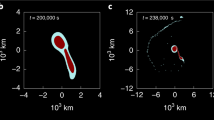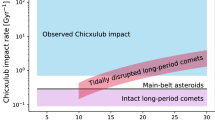Abstract
COMETS are presumed to enter the inner Solar System from the Oort cloud, a repository of comets more than 104 AU from the Sun. Provided the perturbing effects of planetary encounters are taken into account, the original orbital energy of a comet can be calculated, and is negative or positive according to whether the comet's orbit is bound or unbound. The Oort effect1 is the tendency for the original energies of long-period (>200-yr) comets to fall within a narrow range: about 25% of such comets have original energies in the upper 0.2% of the total energy range. In addition, 10% of long-period comets are unbound, and it has been found2 that positive original energy correlates with distance of closest approach to the Sun. We report here a further correlation: unbound comets are more likely to move in retrograde orbits. We suggest that this anomaly comes about because of the omission from the orbital energy determination of non-gravitational effects arising from enhanced volatility.
This is a preview of subscription content, access via your institution
Access options
Subscribe to this journal
Receive 51 print issues and online access
$199.00 per year
only $3.90 per issue
Buy this article
- Purchase on Springer Link
- Instant access to full article PDF
Prices may be subject to local taxes which are calculated during checkout
Similar content being viewed by others
References
Oort, J. H. Bull. astr. Inst. Neth. 11, 91–110 (1950).
Marsden, B. G., Sekanina, Z. & Everhart, E. Astr. J. 83, 64–71 (1978).
Marsden, B. G. & Sekanina, Z. Astr. J. 78, 1118–1124 (1973).
Duncan, M., Quinn, T. & Tremaine, S. Astr. J. 94, 1330–1338 (1987).
Hills, J. G. Astr. J. 86, 1730–1740 (1981).
Byl, J. Earth Moon Planets 36, 263–273 (1986).
Heisler, J. & Tremaine, S. Icarus 65, 13–26 (1986).
Heisler, J., Tremaine, S. & Alcock, C. Icarus 70, 269–288 (1987).
Matese, J. J. & Whitman, P. G. Icarus 82, 389–401 (1989).
Morris, D. E. & Muller, R. A. Icarus 65, 1–12 (1986).
Torbett, M. V. Mon. Not. R. astr. Soc. 223, 885–895 (1986).
Yabushita, S. Mon. Not. R. astr. Soc. 231, 723–733 (1988).
Yabushita, S. Astr. J. 97, 262–264 (1989).
Marsden, B. G. Catalogue of Cometary Orbits 6th edn (Smithsonian Astrophysical Observatory, Cambridge, Massachusetts, 1989).
Meyer, S. L. Data Analysis, 254–290 (Wiley, New York, 1975).
Press, W. H., Flannery, B. P., Teukolsky, S. A. & Vetterling, W. T. Numerical Recipes, 464–497 (Cambridge University Press, 1986).
Leinert, C. I., Richter, I., Pitz, E. & Planck, B. Astr. Astrophys. 103, 177–188 (1981).
Leinert, C. I., Roser, S. & Buitriago, J. Astr. Astrophys. 118, 345–357 (1983).
Grun, E., Zook, H. A., Fechtig, H. & Giese, R. H. Icarus 62, 244–272 (1985).
Marsden, B. G. & Sekanina, Z. Astr. J. 76, 1135–1151 (1971).
Author information
Authors and Affiliations
Rights and permissions
About this article
Cite this article
Matese, J., Whitman, P. & Whitmire, D. Gravitationally unbound comets move in predominantly retrograde orbits. Nature 352, 506–508 (1991). https://doi.org/10.1038/352506a0
Received:
Accepted:
Issue Date:
DOI: https://doi.org/10.1038/352506a0
This article is cited by
-
Constant of Motion, Lagrangian and Hamiltonian of the Gravitational Attraction of Two Bodies with Variable Mass
International Journal of Theoretical Physics (2007)
-
A model of the galactic tidal interaction with the oort comet cloud
Celestial Mechanics and Dynamical Astronomy (1992)
Comments
By submitting a comment you agree to abide by our Terms and Community Guidelines. If you find something abusive or that does not comply with our terms or guidelines please flag it as inappropriate.



